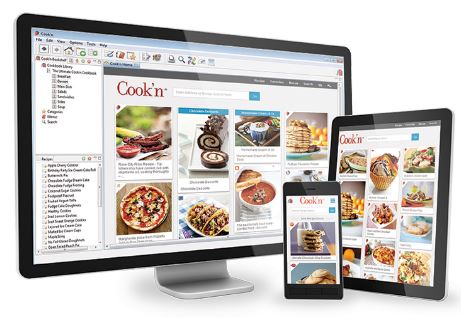How to Save Favorite Articles to Cook’n

You may have noticed that I often suggest that you create customized chapters in your Cook’n 11 software. I’m always doing this—I love to categorize things. Here are a few of the customized chapters I’ve created:
- Time-saving recipes
- Picnic ideas (quick recipes, foods that travel well, serving ideas, etc.)
- Chia seed recipes
- Raw food recipes
- Favorite meatless meals
- Resources for organic produce and grass-fed meats
- Favorite grain-free recipes
- Coconut oil recipes
- Homemade beauty and bath products recipes
- Fresh herb recipes
- Cooking for 2 recipes
- Unique uses for the slow cooker
- Unique uses for the rice cooker
- Health and healthy eating information
However, we’ve had readers comment that they’ve tried that and it hasn’t worked for them. But what these readers are trying to load are articles without recipes (and I provide lots of those for this newsletter). So it’s time to learn how.

With this in mind, I thought I’d share these important HOW-TO instructions from Dan’s Executive Assistant, Barbara. She knows exactly how to help you get your newsletter articles (or any article you find on the Internet) into your Cook’n 11. Here’s what she says:
“Because there is not a recipe in some articles, they will not download into Cook'n.
“But here’s what you can do: Within Cook’n you would create a Cookbook, then create a Chapter, then you click open a ‘new’ recipe and give the recipe a name, such as '9 Tasty Uses for Chia Seeds.' Then you would copy and paste the entire article from the newsletter into the DIRECTIONS area of Cook’n.
“The article will look really nice when you look at it in Cook'n. This is a quick way to save things you want to use later, which is one of the wonderful things about this amazing software.”
I agree with Barbara about this feature. I use Cook’n to hold just about everything related to food. I find HOW-TO articles and cooking advice online all the time, and since Cook’n came along, I now have a place to house all this useful information.

For instance, I’ve struggled with mushroom storage—they get slimy too soon. So after some net surfing, I found Tip Busters, and they straightened me out:
“How do you store mushrooms, when different sources give you different instructions? On the mushroom bag it says to store them in the paper bag. Mushrooms Canada says that they store well in the commercial container until they are opened, at which point they should be transferred to a paper bag. Cook’s Illustrated states that the original container is the best container; that they dry out in the paper bag. Numerous sites have other ideas: paper towel in a plastic bag, paper towel in a paper bag, damp paper towel, etc.
“So what’s the best method—what actually works? The #1 – BEST way is to wrap mushrooms together in a paper towel, inside a perforated plastic bag (such as a Ziploc® brand produce bag).”
I copied this information into a WORD document then followed Barbara’s explanation, and now voila! I have a helpful chapter titled “Tips That Work.” And of course, I also include the website address. I use mushrooms all the time, though, so I’m thinking I’ll create a “Mushroom Recipes” chapter and move this article out of TIPS THAT WORK and into this recipes chapter.
Now that Barbara’s explained the process, the sky’s the limit on all the important and useful material we can organize!
- www.dvo.com
- www.tipbusters.com
 Alice Osborne
Alice Osborne
Weekly Newsletter Contributor since 2006
Email the author! alice@dvo.com
